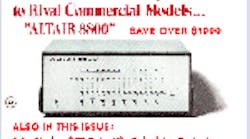Popular Electronics article on the Altair 8800
A recent issue of Time magazine included the obituary of H. Edward Roberts. As many of you may know, Ed authored the famous article in Popular Electronics on the Altair 8800. When I read the obit, it brought back a flood of memories of my first editorial job in the electronics industry.
Art Salsberg, then editor-in-chief at Popular Electronics, hired me as a technical editor in September 1980. Though more than five years had passed since the publication of that watershed article, Art let me know about it from day one on the job. Both he and Les Solomon, a technical editor at the time, were instrumental in bringing it to fruition.
PROJECT BREAKTHROUGH
The article, “Altair 8800 The most powerful minicomputer project ever presented—can be built for under $400,” was the cover story of the January 1975 issue of Popular Electronics (see the figure). The kit itself cost only $397, which was quite a breakthrough. But to get any kit published in PE, you had to send the working prototype to the Ziff-Davis offices in New York City to prove that you indeed could get it to work.
This particular kit posed a problem, since it was not something that the staff could easily check out, like an audio amplifier or calculator. In addition, no one on the staff had ever seen or worked with a computer like this. So Ed had to travel from Albuquerque, N.M., where he was based, to New York to demonstrate the computer in action.
As the guys told me, Ed shipped the computer to the office rather than drag it with him, but it got lost in transit! Art and Les trusted him enough that they published the article without seeing the working prototype. The computer shown on the cover is actually just a mockup of the one Ed had built.
Not long after I arrived, I found out Paul Freiberger and Michael Swain were writing a book on the whole experience called Fire in the Valley. A big buzz circulated in the office on the day the authors came in to interview Art and Les.
I found the historical accounts fascinating as both Art and Les recounted their memories regarding the publication of the article. It seemed to me that both were trying to lay claim to having the bigger impact on the publication of the article, though in truth the article could not have been published without both of their efforts.
There is a photo in the book of both holding the issue, which is a fitting tribute to their roles in publishing this breakthrough story. Fire in the Valley was also the basis for Pirates of Silicon Valley, a made-for-TV movie that aired on cable television back in 1999.
Roberts co-authored the article with an engineer, Bill Yates (that’s Yates, not Gates), who worked at his company, MITS. The second part of the article ran in the February 1975 issue. You can find parts one and two at www.swtpc.com/mholley/PopularElectronics/Jan1975/PE_Jan1975.htm and www.swtpc.com/mholley/PopularElectronics/Feb1975/PE_Feb1975.htm, respectively.
How did the computer get the name Altair? Les told me many times that his 12-year-old daughter had been responsible for the name. As the story goes, he asked her opinion while she was watching an episode of Star Trek. She came up with Altair, since the Enterprise was travelling to Altair in that particular episode.
Paul Allen, one of the founders of Microsoft, wrote the obituary in Time. In the movie, there is a scene that shows Allen bursting into his friend’s dorm room with a copy of Popular Electronics in his hand. Who was the friend? Bill Gates, of course.
Gates was attending Harvard at the time. But when the duo sold Roberts on a version of BASIC for the Altair, they were off and running with their new company called Micro-Soft, which eventually became Microsoft.
I never met Ed Roberts or even worked with him while I was at Popular Electronics. Les usually handled the editing of his articles. But Ed had an enormous impact on me anyway, since I was hired for my expertise with the Apple II computer.
Ed’s minicomputer kit, which was based on the Intel 8080 microprocessor, paved the way for other personal computers like the 6502-based Apple II and eventually the 8088-based IBM PC. If you think back, Ed’s work may have had an effect on your career as well.


